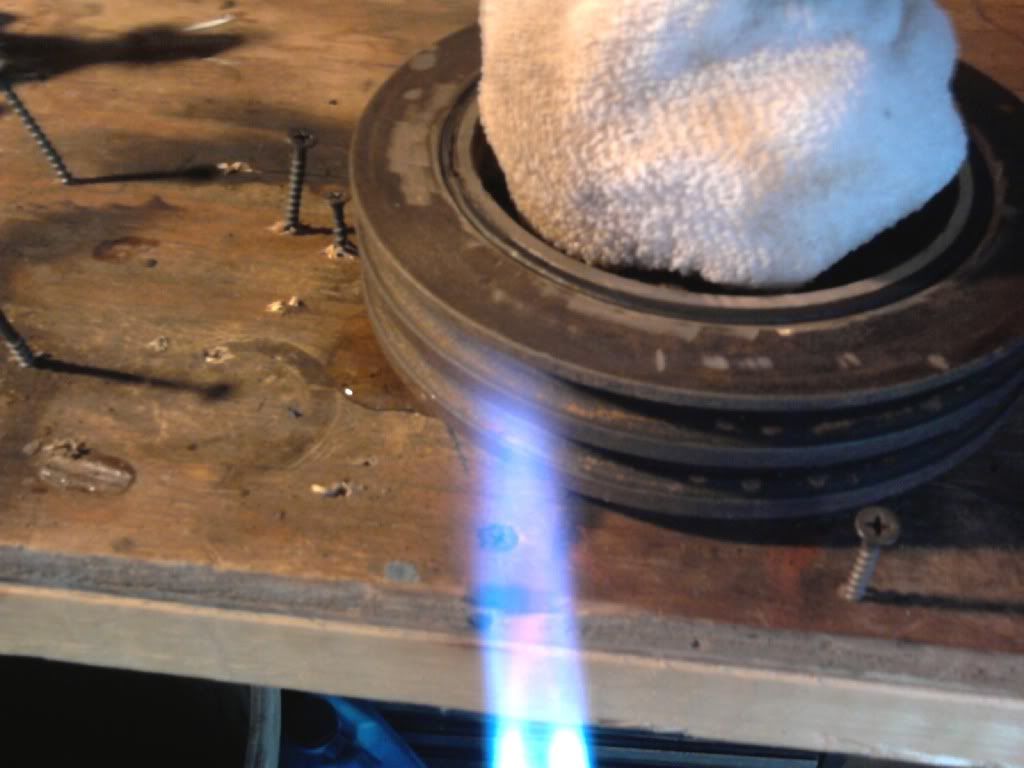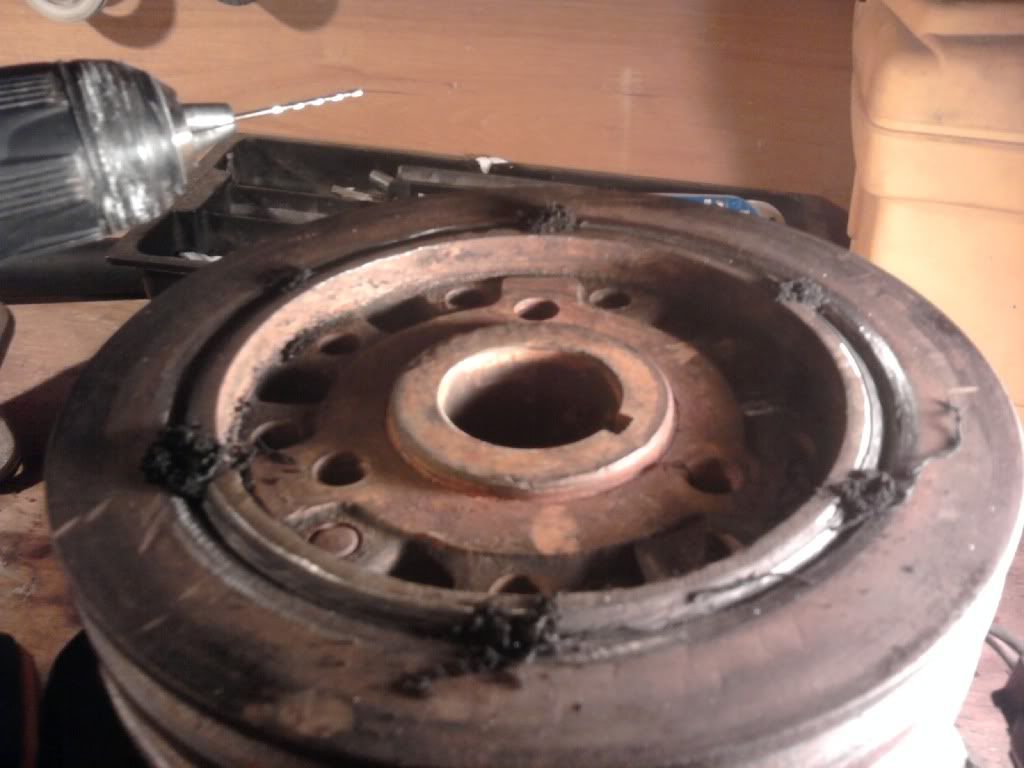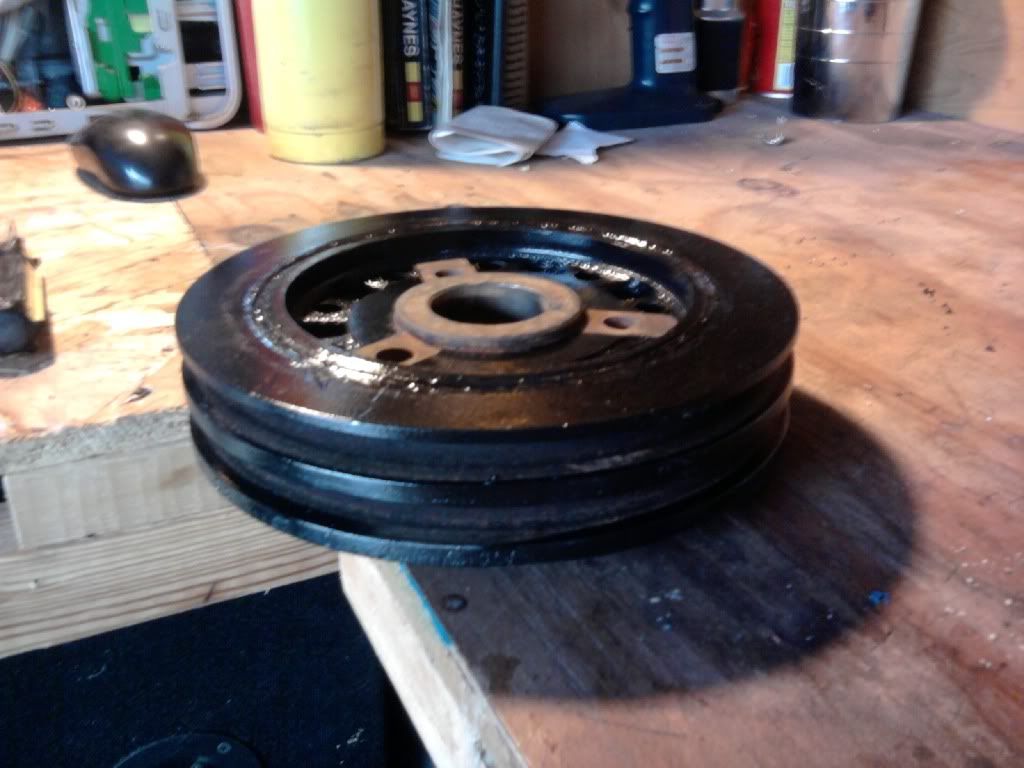Pulley Pains
#16
because balancer is actually the wrong term. They are technically Harmonic Dampeners and don't "balance" anything. And Dampener is the proper name for them.
The term balancer came into being because SOME engines are externally balanced and thus have the in-balance done on the "balancer"
The term balancer came into being because SOME engines are externally balanced and thus have the in-balance done on the "balancer"

Usually on harmonic dampers, once they spin on the rubber, they'll just do it again, and again. The rubber/adhesive is breaking down and decaying. It's not something you can usually keep an eye on. Sometimes they slowly walk off (and into your fan or front cover) but a lot of the time the outer ring just flies right off and smashes up your fan, radiator, and various front drive accessories. Not to mention, it's harmonic damping abilities will decrease the less the outer ring adhered to the ring.
Is saving $200 now really worth a destroyed fan, radiator, being stranded on the side of the road and a possible cracked crankshaft?
#17
Breaker bar on the center bolt + a very long chain-type strap wrench.  It's only about 30 degrees to the left and was dead nuts just 7 months/ 30 miles ago.
It's only about 30 degrees to the left and was dead nuts just 7 months/ 30 miles ago.
I can dream!!
For one, the ring is moving backwards toward the crank spacer and for it to move much farther, It would have to throw both belts first before completely letting go. So throwing a belt would be the first warning. Also, the power steering pulley prevents it from moving forward. As I have learned here, due to the engine's internal balance, the rotation of the ring may not be an issue.
Currently this car gets driven roughly 30 miles per year. I havent yet taken it farther than around the block. This has been a terrible year financially and it has recently gotten much worse so the $200 isnt even there to be saved. The failure is in it's early stages so attempting to 'fix' it can't hurt. The engine will probably only see another 2 hours of run-time between now and whenever I can get a new damper.
 It's only about 30 degrees to the left and was dead nuts just 7 months/ 30 miles ago.
It's only about 30 degrees to the left and was dead nuts just 7 months/ 30 miles ago.I can dream!!
Actually the term is "damper". A dampener is something that makes something damp
Usually on harmonic dampers, once they spin on the rubber, they'll just do it again, and again. The rubber/adhesive is breaking down and decaying. It's not something you can usually keep an eye on. Sometimes they slowly walk off (and into your fan or front cover) but a lot of the time the outer ring just flies right off and smashes up your fan, radiator, and various front drive accessories. Not to mention, it's harmonic damping abilities will decrease the less the outer ring adhered to the ring.
Is saving $200 now really worth a destroyed fan, radiator, being stranded on the side of the road and a possible cracked crankshaft?
Usually on harmonic dampers, once they spin on the rubber, they'll just do it again, and again. The rubber/adhesive is breaking down and decaying. It's not something you can usually keep an eye on. Sometimes they slowly walk off (and into your fan or front cover) but a lot of the time the outer ring just flies right off and smashes up your fan, radiator, and various front drive accessories. Not to mention, it's harmonic damping abilities will decrease the less the outer ring adhered to the ring.
Is saving $200 now really worth a destroyed fan, radiator, being stranded on the side of the road and a possible cracked crankshaft?
Currently this car gets driven roughly 30 miles per year. I havent yet taken it farther than around the block. This has been a terrible year financially and it has recently gotten much worse so the $200 isnt even there to be saved. The failure is in it's early stages so attempting to 'fix' it can't hurt. The engine will probably only see another 2 hours of run-time between now and whenever I can get a new damper.
#18
The engine being internally balanced has absolutely nothing to do with the damper. In the normal running of an engine, harmonics are introduced into the crankshaft. At certain RPMs, the frequency can reach the resonance frequency of the crankshaft - and fatigue/crack it. The rubber and outer ring of the damper acts as a spring, to counteract those minor vibrations that cannot be balanced out.
If it only gets driven 30 miles a year, than whatever.
If it only gets driven 30 miles a year, than whatever.
#19
What I meant by this is since (in my case)the engine's balance is not done with the damper, I may not have to worry (save for the timing marks) about re-orienting the outer ring back in relation to the inner core - although I intend to try.
#20
#21
#23
Time for an update! Lots of issues including a nasty flu had this project on the back burner for a bit but I finally wrapped it up today:
Plan A was to use a hypodermic needle to inject superglue into the damper - I browsed a couple stores for a syringe but didnt see any hanging around and I was too chicken to ask! It appears that they are available by Rx only anyway. No biggie.
It appears that they are available by Rx only anyway. No biggie.
I attempted to decrease the tolerance between the inner and outer pieces by cooling the center with ice and heating the inertia ring with a torch. I used this technique several times during the repair.

To keep the rubber in place, I applied superglue only to bond it to the inner ring, let dry over night, then used a 3-jaw puller to bring the outer inertia ring back into place.
Next, I ground off the excess rubber and cut a groove with a dremel between the rubber and the inertia ring. (completed in the pic above)
I applied heat and cold as described above and then applied superglue. It sucked it right in just like a solder joint! (Process repeated on the backside also.)

Finally, I drilled twelve 1/16" holes in the rubber between it and the outer ring to further ensure penetration of the glue. Performed heat/cold trick again, then injected the holes with glue plus one final application to fill the groove.
I let it dry overnight again, then applied a thick coat of Rustoleum Industrial:

Today I put everything back together, scribed a new TDC mark, and ran it to operating temp for about 20 minutes. So far so good!
I will update this thread over the next year or so, noting any changes.
Plan A was to use a hypodermic needle to inject superglue into the damper - I browsed a couple stores for a syringe but didnt see any hanging around and I was too chicken to ask!
 It appears that they are available by Rx only anyway. No biggie.
It appears that they are available by Rx only anyway. No biggie.I attempted to decrease the tolerance between the inner and outer pieces by cooling the center with ice and heating the inertia ring with a torch. I used this technique several times during the repair.

To keep the rubber in place, I applied superglue only to bond it to the inner ring, let dry over night, then used a 3-jaw puller to bring the outer inertia ring back into place.
Next, I ground off the excess rubber and cut a groove with a dremel between the rubber and the inertia ring. (completed in the pic above)
I applied heat and cold as described above and then applied superglue. It sucked it right in just like a solder joint! (Process repeated on the backside also.)

Finally, I drilled twelve 1/16" holes in the rubber between it and the outer ring to further ensure penetration of the glue. Performed heat/cold trick again, then injected the holes with glue plus one final application to fill the groove.
I let it dry overnight again, then applied a thick coat of Rustoleum Industrial:

Today I put everything back together, scribed a new TDC mark, and ran it to operating temp for about 20 minutes. So far so good!
I will update this thread over the next year or so, noting any changes.

Thread
Thread Starter
Forum
Replies
Last Post
460PoweredRV
1987 - 1996 F150 & Larger F-Series Trucks
2
01-24-2018 10:31 PM
Oprah86
1980 - 1986 Bullnose F100, F150 & Larger F-Series Trucks
21
01-13-2018 05:46 PM
LTCPipkin
Explorer, Sport Trac, Mountaineer & Aviator
1
04-24-2011 02:22 PM
jj22ee
FE & FT Big Block V8 (332, 352, 360, 390, 406, 410, 427, 428)
1
02-25-2011 07:37 PM
Pubert
FE & FT Big Block V8 (332, 352, 360, 390, 406, 410, 427, 428)
5
06-29-2010 07:55 AM





